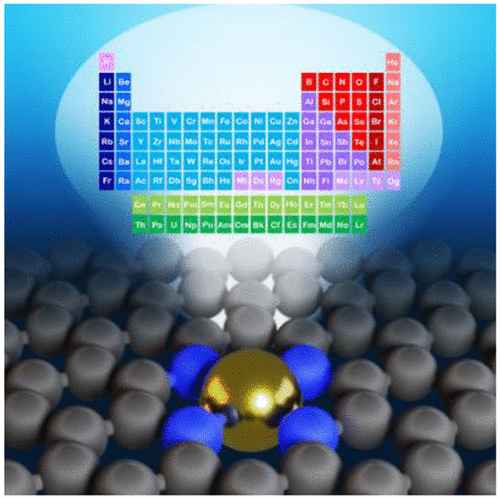当前位置:
X-MOL 学术
›
Chem. Rev.
›
论文详情
Our official English website, www.x-mol.net, welcomes your
feedback! (Note: you will need to create a separate account there.)
Single-Atom Catalysts across the Periodic Table
Chemical Reviews ( IF 51.4 ) Pub Date : 2020-10-21 , DOI: 10.1021/acs.chemrev.0c00576 Selina K. Kaiser 1 , Zupeng Chen 1 , Dario Faust Akl 1 , Sharon Mitchell 1 , Javier Pérez-Ramírez 1
Chemical Reviews ( IF 51.4 ) Pub Date : 2020-10-21 , DOI: 10.1021/acs.chemrev.0c00576 Selina K. Kaiser 1 , Zupeng Chen 1 , Dario Faust Akl 1 , Sharon Mitchell 1 , Javier Pérez-Ramírez 1
Affiliation

|
Isolated atoms featuring unique reactivity are at the heart of enzymatic and homogeneous catalysts. In contrast, although the concept has long existed, single-atom heterogeneous catalysts (SACs) have only recently gained prominence. Host materials have similar functions to ligands in homogeneous catalysts, determining the stability, local environment, and electronic properties of isolated atoms and thus providing a platform for tailoring heterogeneous catalysts for targeted applications. Within just a decade, we have witnessed many examples of SACs both disrupting diverse fields of heterogeneous catalysis with their distinctive reactivity and substantially enriching our understanding of molecular processes on surfaces. To date, the term SAC mostly refers to late transition metal-based systems, but numerous examples exist in which isolated atoms of other elements play key catalytic roles. This review provides a compositional encyclopedia of SACs, celebrating the 10th anniversary of the introduction of this term. By defining single-atom catalysis in the broadest sense, we explore the full elemental diversity, joining different areas across the whole periodic table, and discussing historical milestones and recent developments. In particular, we examine the coordination structures and associated properties accessed through distinct single-atom–host combinations and relate them to their main applications in thermo-, electro-, and photocatalysis, revealing trends in element-specific evolution, host design, and uses. Finally, we highlight frontiers in the field, including multimetallic SACs, atom proximity control, and possible applications for multistep and cascade reactions, identifying challenges, and propose directions for future development in this flourishing field.
中文翻译:

周期表中的单原子催化剂
具有独特反应性的分离原子是酶催化和均相催化剂的核心。相反,尽管该概念早已存在,但是单原子非均相催化剂(SAC)直到最近才获得关注。主体材料具有与均相催化剂中的配体相似的功能,确定了离析原子的稳定性,局部环境和电子性质,因此为针对目标应用定制非均相催化剂提供了平台。在短短十年内,我们目睹了许多SAC的例子,它们以其独特的反应性破坏了异质催化的不同领域,并极大地丰富了我们对表面分子过程的理解。迄今为止,术语“ SAC”主要是指基于后期过渡金属的系统,但是存在许多例子,其中其他元素的孤立原子起着关键的催化作用。这篇评论提供了SAC的组成百科全书,以庆祝该术语的引入十周年。通过广义地定义单原子催化,我们探索了全部元素的多样性,在整个元素周期表中加入了不同区域,并讨论了历史里程碑和最新进展。特别是,我们研究了通过不同的单原子-主体组合获得的配位结构和相关性质,并将它们与它们在热,电和光催化中的主要应用相关联,揭示了特定于元素的演化,主体设计和用途的趋势。 。最后,我们重点介绍了该领域的前沿领域,包括多金属SAC,原子接近控制,
更新日期:2020-11-12
中文翻译:

周期表中的单原子催化剂
具有独特反应性的分离原子是酶催化和均相催化剂的核心。相反,尽管该概念早已存在,但是单原子非均相催化剂(SAC)直到最近才获得关注。主体材料具有与均相催化剂中的配体相似的功能,确定了离析原子的稳定性,局部环境和电子性质,因此为针对目标应用定制非均相催化剂提供了平台。在短短十年内,我们目睹了许多SAC的例子,它们以其独特的反应性破坏了异质催化的不同领域,并极大地丰富了我们对表面分子过程的理解。迄今为止,术语“ SAC”主要是指基于后期过渡金属的系统,但是存在许多例子,其中其他元素的孤立原子起着关键的催化作用。这篇评论提供了SAC的组成百科全书,以庆祝该术语的引入十周年。通过广义地定义单原子催化,我们探索了全部元素的多样性,在整个元素周期表中加入了不同区域,并讨论了历史里程碑和最新进展。特别是,我们研究了通过不同的单原子-主体组合获得的配位结构和相关性质,并将它们与它们在热,电和光催化中的主要应用相关联,揭示了特定于元素的演化,主体设计和用途的趋势。 。最后,我们重点介绍了该领域的前沿领域,包括多金属SAC,原子接近控制,











































 京公网安备 11010802027423号
京公网安备 11010802027423号